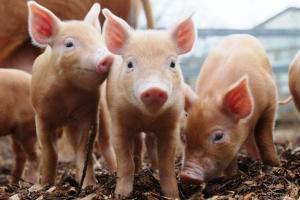Growth traits pigs affected by indirect genetic effects

Production traits such as growth rate may depend on the social interactions between group members. Research from Wageningen University in the Netherlands put this to the test.
The social interactions of pigs in a group may be partly heritable and are referred to as indirect genetic effects (IGE) or social, associative, or competitive genetic effects. Indirect genetic effects may contribute to heritable variation in traits and can therefore be used to increase the response to selection. This, however, has hardly been tested by selection experiments.
The objective of the current study was to determine the effects of one generation of selection on IGE for growth (IGEg) in pigs on ADG, BW, ADFI, feed efficiency, and post-mortem measurements. Sires (n = 24) and dams (n = 64) were selected to create a high vs. low contrast for IGEg in the offspring (n = 480). The IGE difference was 2.8 g ADG per pen mate, corresponding to 14 g higher ADG in high IGEg offspring compared to low IGEg offspring when housed in groups of 6 (i.e., (6 – 1) × 2.8 = 14). Male (barrows) and female (gilts) offspring were housed in groups of 6 of the same IGEg classification, in either barren concrete pens or pens enriched with straw and wood shavings (n = 80 pens).
Effect IGE on growth parameters
Pigs were followed from birth to slaughter. Data were analysed in a mixed model with pen as random factor. There was no difference in ADG between high and low IGEg pigs during the finishing period (wk 10 to 23). Opposite to expectations, high IGEg tended to have a 17 g lower ADG from weaning to slaughter (P = 0.08), which was caused by a higher BW of low IGEg pigs in wk 5 (P = 0.008). This led to a 2.3 kg lower carcass weight (P = 0.02) and 2.2 mm less muscle depth for high IGEg pigs (P = 0.03). High IGEg pigs had a higher stomach wall damage score (P = 0.01). Pigs on straw had a 25 g lower ADG during finishing (P = 0.03) and less stomach wall damage (P < 0.001). Fewer interventions against harmful behaviour were required in high IGEg pigs.
More tests needed
The unexpected results regarding IGEg may be due to several reasons. Despite initial power calculations showing good power, the IGEg contrast between groups may have been too small. Moreover, measures that were taken to limit harmful behaviour may have had a substantial role. Harmful behaviour such as tail biting may affect ADG and might underlie the effects of selection on IGEg in pigs. Research under commercial circumstances, where harmful behaviour is likely to be more profound, may give more accurate insight into the benefits of selecting for IGEg.
The full article has been published in the June edition of the Journal of Animal Science.











